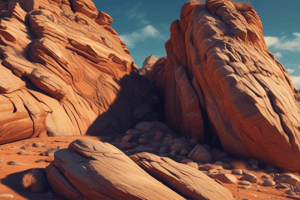Podcast
Questions and Answers
What are sedimentary rocks formed through?
What are sedimentary rocks formed through?
- Erosion
- Cementation
- Weathering
- All of the above (correct)
What is compaction in sedimentary rock formation?
What is compaction in sedimentary rock formation?
The weight from the layers of sediments forces out fluids and decreases the space between grains.
What does cementation refer to in sedimentary rocks?
What does cementation refer to in sedimentary rocks?
When minerals dissolved in water crystallize between sediment grains.
How are sedimentary rocks identified?
How are sedimentary rocks identified?
Which type of sedimentary rock is identified by clastic size and shape?
Which type of sedimentary rock is identified by clastic size and shape?
What are clastic rocks made of?
What are clastic rocks made of?
What characterizes chemical sedimentary rocks?
What characterizes chemical sedimentary rocks?
What is the most common biochemical sedimentary rock?
What is the most common biochemical sedimentary rock?
What are biochemical rocks?
What are biochemical rocks?
What are clasts?
What are clasts?
Flashcards are hidden until you start studying
Study Notes
Sedimentary Rock Formation
- Formed through natural processes involving the uplift, weathering, erosion, deposition, compaction, and cementation of pre-existing rocks.
- Sediment layers accumulate over time, with younger layers burying older layers.
- Additional sediment deposits can further bury existing layers.
Compaction
- The process where the weight from overlying sediment layers reduces fluid content and decreases spacing between grains.
Cementation
- Occurs when dissolved minerals in water crystallize between sediment grains, binding them together.
Sedimentary Rock Identification
- Classified based on formation processes, including deposition, compaction, cementation, and evaporation.
- Key characteristics include composition of sediments, rock fragments, minerals, or organic materials.
Clastic Sedimentary Rocks
- Identified based on clastic size and shape, but size alone does not indicate formation environment.
- Example: Sandstone, which has a gritty texture resembling sugar; shape of clasts can indicate formation environment.
Clastic Rocks
- Composed of broken pieces of minerals and rock fragments, categorized as clastic sedimentary rocks.
Chemical Sedimentary Rocks
- Form when water saturated with dissolved minerals allows particles to crystallize.
- Often features an interlocking crystalline texture, resembling igneous rocks and typically composed of one dominant mineral.
Chemical Rocks
- Created from the direct crystallization of minerals from water.
Biochemical Sedimentary Rocks
- Limestone is a primary example, formed from marine organisms that utilize dissolved minerals to create shells.
- After the organisms die, their shells accumulate on the seafloor, where they are compacted and cemented into limestone.
Biochemical Rocks
- Made by or containing the remains of organisms, representing a key type of sedimentary rock.
Clasts
- Refers to the broken pieces and fragments that compose clastic sedimentary rocks.
Studying That Suits You
Use AI to generate personalized quizzes and flashcards to suit your learning preferences.




